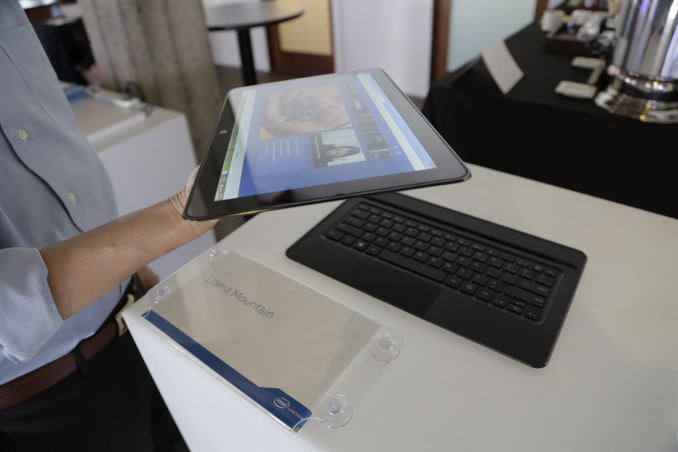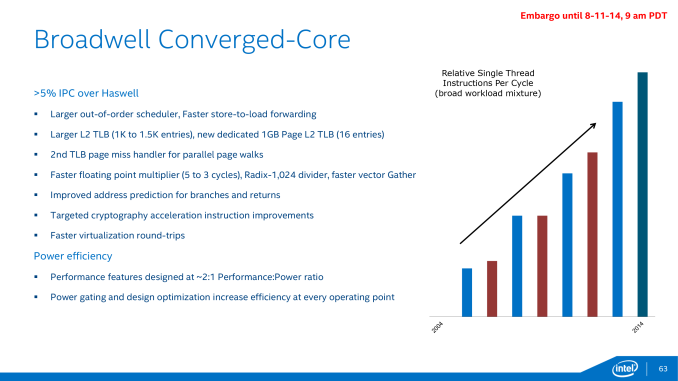Intel Broadwell Architecture Preview: A Glimpse into Core M
by Ryan Smith on August 11, 2014 12:01 PM ESTClosing Thoughts
Wrapping up our preview of the Broadwell architecture and Intel’s Core M processor, the bulk of Intel’s presentation and focus today is on the latter, so that is where we’ll start.
Core M is not a make-or-break product for Intel, but none the less it is a very important one. Mobile devices – be it tablets, slates, transformers, 2-in-1s etc – are continuing to increase in popularity, and as we’ve seen with ARM based tablets so far they form a market that has continued to grow and continued to erode the x86 laptop market that Intel has dominated for so long. Though laptops as a category are not going anywhere any time soon, their erosion means that Intel needs to get into mobile devices if they want to maintain their sales and their stature. To that end it’s not too late for Intel to break into this market and turn things around, but if they’re going to succeed then they need to make their move sooner or later, and this is where Core M fits in.
It’s telling then that while Intel is going after this market with a Core architecture, they are doing so under a different Core brand. Core M doesn’t just represent a new low powered Core CPU, but in Intel’s eyes is another product entirely. One that is so different that it does away with the Core i3/i5/i7 convention entirely and gets its own brand name and own product numbers. Core M is still Core, but it is nearly unrecognizable compared to the Core of even 4 years ago.
As far as the Core M product is concerned then, while Intel’s plans are grand they are not without merit. Backed by Intel’s new 14nm process and the Broadwell architecture, Core M looks like it should finally resolve the issues that dogged even Haswell-Y by bringing down power consumption even further while improving on Intel’s already strong performance, and getting the resulting processor in an SoC small enough to be usable in even the thinnest mobile devices. In fact from a technical perspective there’s little reason to doubt Core M; we’ll still have to wait to see just how good the resulting retail products are, but there shouldn’t be any technical reason for why it can’t be put into a mobile device comparable to today’s 10”+ tablets. Intel’s own Llama Mountain reference design can vouch for that much, showcasing the viability of Core M in a 12.5” tablet that’s just 7.2mm thick.
Intel's Llama Mountain, a Core M form factor reference design
More likely what will determine Core M’s fate and Intel’s ability to completely break into the mobile device market will be pricing. Intel’s profit margins are somewhat legendary in the computer industry, and a big part of that profitability has come from the high prices Intel has enjoyed from products such as their Core processors. Core M, like the other Cores before it, will still be an upscale product – a higher priced, higher performance alternative to Intel’s mass-market Atom processors. And while that makes plenty of sense on paper, in the real world Intel has to face the AllWinners and other ARM vendors of the world who are happy to sell their ARM SoCs at significantly lower margins, which can have a knock-on effect even if they can’t compete with Intel on overall performance. At this point it’s far too early to call this, especially when Intel isn’t even discussing Core M pricing at this time, but it’s a subject that Intel will have to consider carefully as “good enough” ARM devices will continue to be the biggest threat to Intel’s position in the CPU market.
Moving on, while today’s release from Intel only offers us a preview of what Intel will be delivering with their Broadwell architecture, what Intel has presented thus far looks to continue Intel’s tradition of relentless execution. As a tick Broadwell is a small but respectable improvement in Intel’s Core architecture, with the expected 5% IPC improvement in-line with previous ticks. For more traditional desktops and laptops it won’t radically change the world, but then it never was meant to. The biggest question for these parts will be whether Broadwell will improve on Haswell’s clockspeeds at all – a clockspeed boost made possible by Intel’s 14nm process – or if we’re going to hold steady similar to what we saw with the last tick, Ivy Bridge.
Meanwhile Broadwell’s GPU improvements are more significant, and in the race to further improve what’s essentially the baseline for PC GPU performance it is always welcome. Furthermore the fact that Intel is now at API feature parity with discrete GPUs is a big deal for Intel and it is a big deal for iGPUs as a whole. What we still want to see is more performance; a single slice seems just about right for Core M, but if we’re talking about larger laptop and desktop parts it would be very nice to see something akin to GT3 become baseline, especially with the die size savings Intel will be seeing from the 14nm process.
Finally, from here the rest of Intel’s 2014 should be rather busy. Next month is Intel’s Fall IDF 2014, at which point we expect we’ll be given a deeper look at Broadwell’s architecture. Past that the first Broadwell-Y based Core M processors will be on the shelves for the holidays, and with it our chance to see Broadwell and Intel’s 14nm process in action. However that will also be our only chance to see Broadwell in action this year; while Core M will ship in time for the holidays, the rest of the Broadwell lineup will not appear until 2015.













158 Comments
View All Comments
AnnonymousCoward - Tuesday, August 12, 2014 - link
You should look at discrete graphics HW sales.tuxRoller - Tuesday, August 12, 2014 - link
Nvidia, which has around 60% of the discrete gpu market, has a yearly revenue of around $4 000 000 000. So, you're looking at a total market of around $7 000 000 000.Johnmcl7 - Tuesday, August 12, 2014 - link
"Maybe not obsess, but to characterise the PC gaming market as ridiculously small, is pretty far off the mark...."I think the original comment was fairly accurate, even in the PC gaming market there's a large proportion of people using Intel graphics cards. Looking at the current Steam survey results, 75% are using Intel processors and 20% overall are using Intel graphics which means around 1 in 3 people with Intel processors on Steam are using the onboard graphics card. The means even among the gaming market there's a lot of integrated cards in use and that's just one small portion as I'd expect most other areas to mainly be using integrated cards.
There are workstation graphics cards but professionals using those are unlikely to be using consumer processors and the enthusiast/workstation processors do not have an integrated graphics card.
zepi - Tuesday, August 12, 2014 - link
I have had steam on my company laptop with just internal GPU just to take part into the sales campains etc. This makes my contribution to 50:50 in terms on dGPU / iGPU, even though 100% of gaming happens with dGPU.AnnonymousCoward - Tuesday, August 12, 2014 - link
So....how do NVIDIA and ATI stay in business? Obviously many people use discrete cards. The fact you say "obsess" tells me you probably don't realize the massive performance difference, and it's not limited to gaming. CAD uses 3D.AnnonymousCoward - Wednesday, August 13, 2014 - link
Doesn't Intel make X-version CPUs that can be overclocked? The OC market is gonna be much smaller than dGPU, and they're already making a dedicated product for that.Krysto - Tuesday, August 12, 2014 - link
Because they are using that anti-competitive tactic to drive out the discrete competition. They force OEMs to buy them bundled, so more and more people say "why should I pay twice for the GPU...I'll just get the Intel one".It's a nasty tactic, Intel has been employing for years, and unfortunately it's working. But it's terribly uncompetitive.
Krysto - Tuesday, August 12, 2014 - link
It's akin to Microsoft bundling IE with Windows "Why would I need to get another browser...I'll just use IE". That tactic WORKED for Microsoft. It only stopped working when they became lazy. But they could've hold the 90 percent market share of IE for a lot longer, if they didn't get lazy.AnnonymousCoward - Tuesday, August 12, 2014 - link
I dunno--anyone who plans to get a discrete card is going to get one, regardless of Intel forcing it onto the CPU.I wonder what percent of the desktop die will be GPU. Maybe with the GPU disabled, the CPU turbo will work better since there will be less heat.
name99 - Tuesday, August 12, 2014 - link
"we’ll still have to wait to see just how good the resulting retail products are, but there shouldn’t be any technical reason for why it can’t be put into a mobile device comparable to today’s 10”+ tablets. "There may not be TECHNICAL reasons, but there are very definite economic reasons.
People think of tablets as cheap devices --- iPad at the high end, but the mass market at $350 or so. This CPU alone will probably cost around $300. MS is willing to pay that for Surface Pro 4; no-one else is, not for a product where x86 compatibility is not essential.
We'll see it in ultrabooks (and various ultrabook perversions that bend or slide or pop into some sort of tablet) but we're not going to see a wave of sub<$1000 products using this.